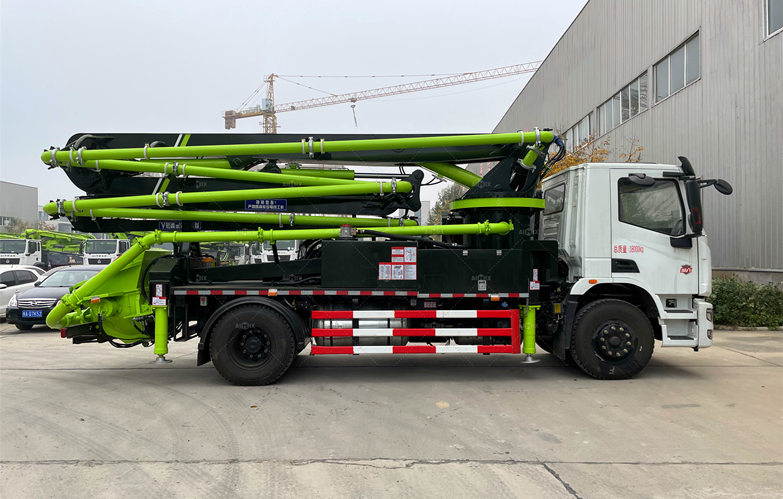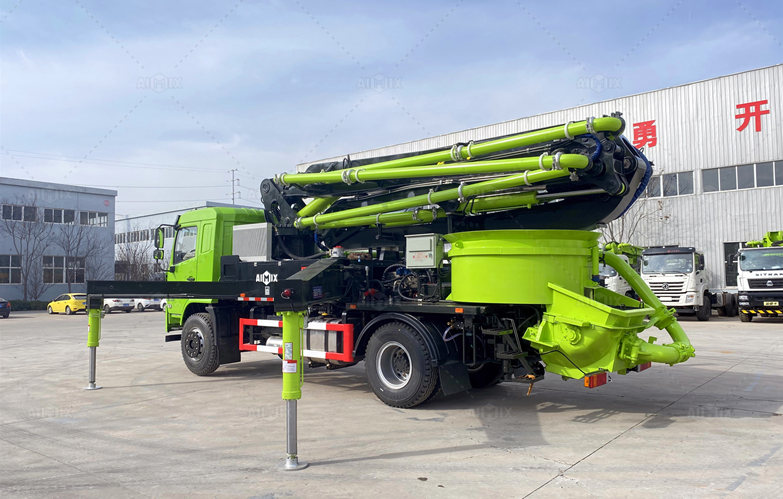When undertaking a large construction project with several work sites, planning the use of concrete boom pumps effectively can lead to significant cost savings. Concrete pumping is a critical part of many construction projects, particularly those involving high-rise buildings, infrastructure works, and large commercial developments. The ability to optimize the use of concrete pumps across multiple sites is not only beneficial for time efficiency but also crucial for reducing overall project costs.

This article will explore how to plan the schedule for using concrete boom pumps, examine the factors influencing the cost of concrete pump, and how you can adjust your strategy to save on overall costs, particularly in large-scale projects that require the transportation of concrete across multiple sites.
Understanding Concrete Boom Pumps and Their Importance in Multi-Site Projects
Concrete boom pumps are specialized pieces of equipment designed to move large quantities of concrete to specific locations at various heights and distances. Unlike traditional methods of concrete delivery, boom pumps use a large articulated arm that can be extended to deliver concrete directly to the job site. These pumps are ideal for high-rise buildings, bridges, and other large-scale infrastructure projects where traditional concrete delivery methods are impractical or inefficient.
In a project with multiple construction sites, such as in urban development, infrastructure development, or multi-building projects, concrete boom pumps are essential to ensure timely and efficient delivery of concrete. However, when managing such large-scale operations, the cost of concrete pump can quickly add up. Therefore, scheduling and coordinating the use of boom pumps across various sites becomes essential in minimizing costs while maintaining project timelines.
Factors That Influence the Cost of Concrete Pumps
Before planning a schedule for your concrete boom pumps, it’s crucial to understand the factors that contribute to the cost of concrete pump usage. These factors can significantly influence your overall budget for the project.
1. Equipment Rental Costs: Depending on the length of the project and the type of pump needed, rental fees can vary. The price for renting a portable concrete pump or a concrete boom pump is typically calculated based on the amount of time the equipment is in use. The concrete pumping machine price may also depend on the pump’s capacity, age, and additional features such as remote control or GPS tracking.
2. Operational Costs: This includes fuel, labor, and maintenance. For projects with several sites, fuel costs can be substantial, particularly if the job sites are spread out over large areas. Labor costs for pump operators and maintenance staff can also impact the budget.
3. Travel and Setup Time: Concrete boom pumps are often mobile, but the time required to transport the pump to various sites, set it up, and ensure it is operating correctly at each location can accumulate. These additional costs must be accounted for when developing a schedule.
4. Pump Capacity and Pumping Distance: Pumps with larger capacities can handle more concrete, making them ideal for larger projects. However, these may also come at a higher rental price. Additionally, the distance the concrete must be pumped will affect the price, as pumping over long distances requires more energy and setup.
5. Duration of Use: The longer the concrete boom pumps are required, the higher the cost will be. Therefore, scheduling the pump’s use efficiently across various work sites will help you control these costs.

Steps to Plan the Schedule of Concrete Boom Pumps Across Multiple Sites
Effective scheduling can help reduce the total cost of concrete pump, transportation, and labor costs. Here are some tips on how to plan the use of concrete boom pumps for multiple sites.
Assess the Concrete Requirements for Each Site
Before scheduling the pumps, you need to understand the concrete needs for each site. Consider the volume of concrete required, the time it will take to pour, and the distance between each site. Knowing how much concrete will be needed and when will help you determine how to allocate concrete boom pumps effectively.
For instance, if Site A requires a large volume of concrete early in the morning and Site B needs a smaller amount later in the day, you can schedule a single pump to work at both sites by adjusting its timing and moving it between locations.
Optimize Pump Usage by Grouping Sites Based on Proximity
Scheduling concrete boom pumps for multiple sites requires a clear understanding of the geography of the project. Grouping sites that are close together can reduce transportation costs and time. Instead of moving a pump back and forth between distant locations, consider dedicating a pump to a specific region of the project for an extended period.
For example, if two construction sites are located within a few kilometers of each other, plan to use the same pump for both sites. This will reduce downtime and the need for extra trips, cutting the mobile portable concrete pump price and making operations more cost-effective.
Use Smaller Pumps for Smaller Jobs
For smaller jobs that require a lower volume of concrete, consider using mini concrete pumps or smaller mobile pumps. These pumps are typically more affordable than large boom pumps and are well-suited for less demanding tasks. By using a smaller pump for smaller pours, you can reduce the total cost of renting larger concrete boom pumps.
In addition, mini concrete pumps are more maneuverable, which can be useful in sites with limited access or in smaller areas. Scheduling smaller pumps for these specific tasks will save both time and money.
Maximize Pump Efficiency by Synchronizing Deliveries
Maximizing the efficiency of your concrete boom pumps requires careful synchronization between pump deliveries and pour schedules. In many cases, concrete must be poured continuously to avoid delays or interruptions in the construction process. To avoid idle time and ensure a steady flow of concrete to each site, you can synchronize deliveries across sites.
This can be achieved by coordinating with the concrete supplier to ensure that the required amount of concrete is ready when the pump arrives at each site. Additionally, setting up a rotation schedule for the pump ensures that once it finishes at one site, it immediately moves to another site without delay. This constant movement helps reduce downtime and minimizes the need for multiple pumps at each site.
Plan for Backup and Maintenance
Even with the best scheduling plan, unexpected issues may arise. For instance, if a concrete pumping machine encounters a mechanical problem, it could result in significant delays. To avoid disruptions in the project timeline, it is crucial to have backup plans in place. This might involve scheduling another concrete boom pump to be on standby, or having a maintenance team ready to address any issues that arise.
Additionally, ensure that you are aware of the concrete boom pumps’ maintenance schedules and perform any necessary checks or maintenance before each use. Proper upkeep ensures that the pumps continue working smoothly without causing unnecessary delays.
Track Pumping Progress with Real-Time Monitoring
Investing in pumps with real-time tracking and monitoring systems, such as GPS or IoT connectivity, can help optimize the scheduling of your concrete boom pumps. By tracking the location and status of the pumps, you can ensure that they are always working efficiently and are properly assigned to the correct sites.
This monitoring system also allows you to adjust schedules in real-time if delays occur or if adjustments are needed. The added visibility helps you avoid inefficiencies and make quick decisions to minimize downtime.
Maximizing Cost Efficiency with Proper Scheduling
In conclusion, properly planning the schedule of concrete boom pumps for a project with multiple sites is critical in minimizing the overall cost of concrete pump rental, fuel, labor, and transportation expenses. By assessing the concrete requirements, grouping sites based on proximity, using smaller pumps for smaller jobs, synchronizing deliveries, and ensuring proper maintenance, you can optimize the use of concrete boom pumps and reduce operational costs significantly. Proper scheduling allows for better resource allocation, quicker project completion, and reduced costs in a project that involves several work sites. By using the right scheduling techniques, project managers can ensure that the mobile concrete pump price and associated expenses are kept to a minimum while maintaining high levels of efficiency and productivity.